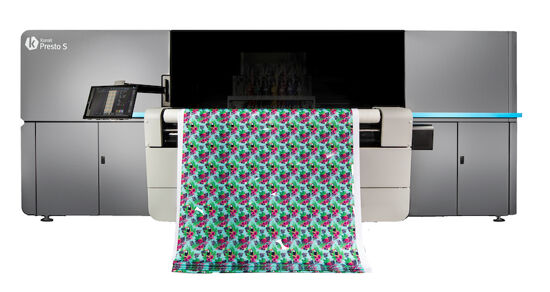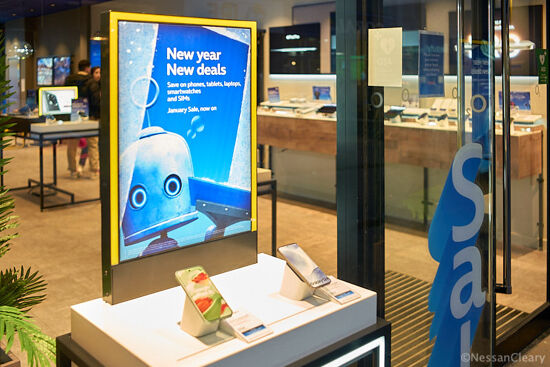Textile print trends for Spring-Summer 2014
Printed designs dominated the 2014 Spring/Summer collections at the recent Fashion Weeks in London, New York, Milan and Paris - printed textiles have never been more on trend.
Fashion website Patternbank’s seasonal preview highlights glorious examples of printed fashion garments and fabrics from a ‘who’s who’ of acclaimed fashion houses.
Geometric shapes, Mondrian-inspired grids, colour-swatch paint splashes and bold brush strokes, illustrative portraits as well as animal, jungle and floral prints, checks and stripes; all were to be seen in the collections. And from the catwalks of fashion’s elite designers, lower cost printed garments will flood onto the high street ready for Spring and Summer next year, keeping the budget-conscious fashionista on trend.
At the heart of the brand
Of course, print has been setting fashion directions for decades. The late Italian fashion designer Gianni Versace, founder of the House of Versace, was one of the first designers to successfully introduce vibrant and exotic prints into his clothing range back in the late 1970s. The impact and success of his use of printed textiles in clothing and accessories was so dramatic that this is a central theme of Versace collections to this day.
The consumer appeal of printed textiles is undiminished, and for the retailers who put print at the heart of their brand, it’s a commercial winner. British designer Cath Kidston, from her passion for prints and an initial investment of just £15,000, has developed a successful global empire now worth £75 million.
Retro-chic: Fabric, garment and accessoriy design by Cath Kidston
Celebrating its 20th anniversary in 2013, Kidston’s retro-printed household goods, bags, clothing, fabrics and accessories can be found in shops all over the world. Similarly, contemporary Irish designer Orla Kiely has developed a distinctive style inspired by the 1960s and 1970s, combined with her love of nature and understanding of print. For both brands, while their ranges continue to expand and evolve, their designs – with print at their core - are covetable and instantly recognisable.
House of Holland Spring/Summer 2014 Collection
Here is the House of Holland Spring/Summer 2014 show from London Fashion Week. This collection is based around Baz Luhrmann's film version of Romeo + Juliet. He was 13 in 1996 when the movie was made, and it made an impact on him that he can't forget. Just check out the retro stylings from the 90's. A hot revival trend that you will be seeing taking London by strom next Spring.
{youtube}NYOD8KwmY5I{/youtube}
Source: FashionTV
Digitally-inspired print revival
Traditionally, printed textiles and wallpapers were the domain of the screen printer. However the introduction and development of digital inkjet technology and specially developed inks have fuelled the trend for smaller digital runs of printed fabrics, clothing and household goods. Thanks to digital, fashion can be fast, responsive, bespoke and even personalised.
{youtube}5kyH7uJ3PGw{/youtube}
T-shirts, for example, once seen as fashion’s poor relation, are fast becoming fashion gold, thanks to the power of digital to deliver garments that reflect micro trends and breaking news. Retail fashion outlets now stock garments featuring digitally imaged prints, logos and slogans which can be on shelves in days, not months.
According to an industry survey highlighted by Jos Bastiaans during his presentation at FESPA 2013’s Creative Corner, fashion accounted for 10% of all digitally printed textiles in 2010, and is set to continue on a strong upward trend, reaching 24% of the digital print textile market by 2014.
Screen appeal
While digital is transforming some areas of the fashion industry, the prevailing mood of austerity stimulates an appetite for all things nostalgic, with consumers drawn to the traditional and the hand-crafted. Screen printing still has a healthy profile in the fashion textile world, for garments and interiors.
London based Insley & Nash is a bespoke textile screen printing and dyeing company that has placed traditional craft printing techniques at the heart of its offering to fashion designers, making innovative use of inks to bring designs to life and grab attention on the stage or catwalk.
On-stage presence: Insley & Nash were commissioned to recreate a heavy jacquard fabric for the stunning Elizabeth I costume for Dr Dee (Damon Albarn’s second Opera). The artwork, inspired by portraits of Elizabeth I, has been created by Insley & Nash. The fabric is screen printed in way to make the fabric look as if it has the pattern woven into it.
Their emphasis is on short runs of high quality textile printing effects that cannot be produced digitally, such as devoré, foil, fluorescents and metallics, and their work attracts an impressive clientele from the fashion, textile, interiors, film and TV industries.
Print has always had a role to play in fashion and textile design over the years, and continues to be a directional influence in fashion for men, women and children alike. Fashion textile and garment manufacturers are already looking to the fashion designers to see what trends will dominate the Autumn/Winter collections for 2014.
As textile and garment printing techniques, inks and materials evolve and generate new opportunities, print will remain part of the fabric of fashion.
Book now
Book your place now at FESPA Digital 2014 and visit FESPA Fabric, the dedicated event for Garment Printers and Decorators.
Topics
Interested in joining our community?
Enquire today about joining your local FESPA Association or FESPA Direct
Recent news

What is digital textile printing and what are the opportunities?
Nessan Cleary shares how textile printing covers a wide range of different market sectors which vary in opportunities. Nessan discusses sportswear, direct to garment and home décor.

Vote now for the FESPA Awards’ People’s Choice Award!
The voting for the prestigious People's Choice FESPA Award is now open until 7th February where those in the industry have the opportunity to vote for their favourite entries, celebrating the exceptional talent in the industry.
.png?width=550)
FESPA MIddle East 2025 - Day 3 Highlights
The third day of FESPA Middle East, 22 January 2025, featured hundreds of professionals visiting the show to see the latest solutions and innovations in speciality print and signage.

The rise of digital screens
Nessan Cleary discusses the increasing use of digital screen in retail shops which have both pros and cons. They can be cost-effective with a variety of different technologies and resolutions that can be used and reduces the amount of short term printing required. However, they do require high amounts of energy to run. Nessan goes into further detail of the pros and cons in this article.